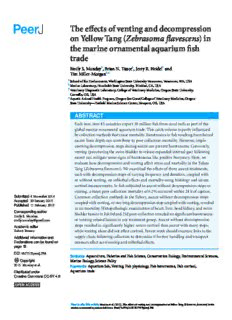
(Zebrasoma flavescens) in the marine ornamental aquarium fish trade PDF
Preview (Zebrasoma flavescens) in the marine ornamental aquarium fish trade
ff The e ects of venting and decompression on Yellow Tang (Zebrasoma flavescens) in the marine ornamental aquarium fish trade EmilyS.Munday1,BrianN.Tissot2,JerryR.Heidel3 and TimMiller-Morgan3,4 1SchooloftheEnvironment,WashingtonStateUniversityVancouver,Vancouver,WA,USA 2MarineLaboratory,HumboldtStateUniversity,Trinidad,CA,USA 3VeterinaryDiagnosticLaboratory,CollegeofVeterinaryMedicine,OregonStateUniversity, Corvallis,OR,USA 4AquaticAnimalHealthProgram,OregonSeaGrant/CollegeofVeterinaryMedicine,Oregon StateUniversity—HatfieldMarineScienceCenter,Newport,OR,USA ABSTRACT Eachyear,over45countriesexport30millionfishfromcoralreefsaspartofthe globalmarineornamentalaquariumtrade.Thiscatchvolumeispartlyinfluenced bycollectionmethodsthatcausemortality.Barotraumainfishresultingfromforced ascentfromdepthcancontributetopost-collectionmortality.However,imple- mentingdecompressionstopsduringascentcanpreventbarotrauma.Conversely, venting(puncturingtheswimbladdertoreleaseexpandedinternalgas)following ascent can mitigate some signs of barotrauma like positive buoyancy. Here, we evaluatehowdecompressionandventingaffectstressandmortalityintheYellow Tang(Zebrasomaflavescens).Weexaminedtheeffectsofthreeascenttreatments, eachwithdecompressionstopsofvaryingfrequencyandduration,coupledwith orwithoutventing,onsublethaleffectsandmortalityusinghistologyandserum cortisolmeasurements.Infishsubjectedtoascentwithoutdecompressionstopsor venting,ameanpost-collectionmortalityof6.2%occurredwithin24hofcapture. Submitted4November2014 Commoncollectionmethodsinthefishery,ascentwithoutdecompressionstops Accepted 20January2015 coupledwithventing,oronelongdecompressionstopcoupledwithventing,resulted Published 17February2015 innomortality.Histopathologicexaminationofheart,liver,headkidney,andswim Correspondingauthor bladdertissuesinfish0dand21dpost-collectionrevealednosignificantbarotrauma- EmilyS.Munday, [email protected] orventing-relatedlesionsinanytreatmentgroup.Ascentwithoutdecompression stopsresultedinsignificantlyhigherserumcortisolthanascentwithmanystops, Academiceditor RobertToonen whileventingalonedidnotaffectcortisol.Futureworkshouldexaminelinksinthe supplychainfollowingcollectiontodetermineiffurtherhandlingandtransport AdditionalInformationand Declarationscanbefoundon stressorsaffectsurvivorshipandsublethaleffects. page15 DOI10.7717/peerj.756 Subjects Aquaculture,FisheriesandFishScience,ConservationBiology,EnvironmentalSciences, Copyright MarineBiology,SciencePolicy 2015 Mundayetal. Keywords Aquariumfish,Venting,Fishphysiology,Fishbarotrauma,Fishcortisol, Aquariumtrade Distributedunder CreativeCommonsCC-BY4.0 OPENACCESS HowtocitethisarticleMundayetal.(2015),TheeffectsofventinganddecompressiononYellowTang(Zebrasomaflavescens)inthe marineornamentalaquariumfishtrade.PeerJ3:e756;DOI10.7717/peerj.756 INTRODUCTION Eachyear,over45countriesremoveandexport14–30millionfishfromcoralreefsas partofthemarineornamentalaquariumtrade(Bruckner,2005;Wood,2001).Although ∼90%offreshwateraquariumfisharesuccessfullycultivatedinaquaculturefacilities,most tropicalmarineaquariumfisharewild-caught(Wood,2001).Collectinglivefishforthe aquariumtradeinvolvesremovingreeffishfromSCUBAdivingdepths(∼10–35m)tothe surface.Collectionisfollowedbytransportingfishfromthecollectionsitetoanexport facilitywheretheyareheldfor1–7dayspriortoshipment.Thefisharethenpackagedin plasticbagswithenoughwatertoturnaroundinand100%oxygen,placedinboxes,and shippedtoanimportfacilitywheretheymaybeheldforseveraldays.Thefishthenare transportedtoaretailstoreand,finally,toahobbyistaquarium.Mortalitymayoccurat anypointinthissupplychain,impactingeachparticipantintheindustry,andnegatively affectingcoralreefsthroughincreasedcollectionpressuretoreplacelosses(Stevenson, Tissot&Dierking,2011;Tissotetal.,2010). Aquariumfisheriesthatusedestructivefishingpractices(e.g.cyanideisusedtostun ornamentalfishforeaseofcapture)havehighfishmortality,andthispracticeisstill widespread(Hall&Bellwood,1995;Hanawaetal.,1998;Rubecetal.,2001;Rubec&Cruz, 2005;Belletal.,2009).WhilefishersinHawaiidonotusecyanidetocollectfish(Walsh etal.,2004),andimmediatemortalityislow(<1%)(Stevenson,Tissot&Dierking,2011), levelsofdelayedmortalityareunknown.Becausefishmoverapidlythroughthesupply chain,itispossiblethataquariumfishersareunawareofcollectionmethodsthatresultin mortalityfurtheralongthesupplychain.Economically,delayedmortalityshiftstheburden offishdeathandmonetarylossfromthecollectortothosefurtheralongthesupplychain (e.g.,theimporter,orhobbyist)whilealsoincreasingthedemandforfishandexacerbating pressureoncoralreefecosystems.Identifyingmethodsthatcausedelayedmortalitywould reducetheoverallmortalityofaquariumfishintheaquariumtrade,andthusthenumber offishremovedfromthereeftocompensatefortheselosses. Inordertoidentifyindustrymethodsthatcausedelayedmortalityinaquariumfish,itis necessarytoexamineeachlinkintheaquariumfishtradesupplychainbothindependently andinsuccession.Inthisstudy,weexaminethefirststepinthesupplychain:removing fishfromdepth(15–18m)tothesurface.Mortalitycausedbyremovinglivefishfromcoral reefdepthstothesurfaceisanimportantandcontroversialissueaffectingtheaquarium fishery;toourknowledge,oursisthefirststudytoexaminethisproblem. Toensurethatfishsurvivethetransitionfromdepthtothesurface,aquariumfishers must either prevent or mitigate barotrauma. Fish experience barotrauma when they are brought to the surface. As water pressure decreases, the volume of swim bladder gasincreases.ThisphenomenonisaresultofBoyle’sLaw,inwhichdecreasingpressure causesanexponentialincreaseingasvolume.Barotraumasignsinfishmanifestboth externallyandinternally,andinclude:positivebuoyancycausedbyoverexpansionofthe swimbladder;bulgingoftheeyes,orexophthalmia;andprotrusionoftheintestinefrom thecloaca.Whilebarotraumahasnotbeenstudiedinshallow-dwelling(15–18m)reeffish caughtfortheaquariumtrade,thereisampleresearchontheeffectsofdepthchangeson Mundayetal.(2015),PeerJ,DOI10.7717/peerj.756 2/19 Table1 Externalandinternalsignsofbarotraumaobservedinfoodfishes. External Internal Gotshall,1964 Esophagealeversion Bruesewitz,Coble&Copes,1993 Esophagealeversion Keniryetal.,1996 Esophagealeversion,positivebuoyancy StJohn&Seyers,2005 Esophagealeversion,exophthalmia Parkeretal.,2006 Esophagealeversion Hannah&Matteson,2007 Esophagealeversion Hannah,Parker&Matteson,2008 Esophagealeversion,exophthalmia Jarvis&Lowe,2008 Subcutaneousgasbubbles,esophageal Arterialembolism,hemorrhage,organtorsion eversion,exophthalmia Nichol&Chilton,2006 Rupturedswimbladder Rogersetal.,2008 Exophthalmia Damagetoanddisplacementoforganssurrounding swimbladder Pribyletal.,2009 Esophagealeversion,exophthalmia Emphysemaofheartventricle Wilde,2009 Esophagealeversion Brownetal.,2010 Cloacalprolapse,exophthalmia,esophageal eversion Pribyletal.,2011 Esophagealeversion Emphysemaofheartventricleandepithelialsurfaces, gasemboliinretemirabileandheadkidney deeperdwelling(20–152m)fishcaughtcommerciallyandrecreationallyforconsumption (Table1). Priorresearchhasdemonstratedthatfishcontinuetoexhibitsublethalinjuries(not having caused death) for extended periods. Rupture of the outer layer of the swim bladder (tunica externa) persisted for at least one month after collection in rockfish (genusSebastes)(Pribyl,2010).Thisindicatesthatsublethalsignsofbarotraumapersist longaftertheinitialtraumaoccurs.Knowingthis,wepredictthatfishcollectedforthe liveornamentalaquariumtradealsosuffersublethalinjuriesthatcouldresultindelayed mortality. Becausebarotraumacanbepotentiallyfataltobothshallower-dwellingaquariumfish anddeeper-dwellingfoodfishalike,fishersimplementmethodsthateitherpreventor mitigateit.Ventingisamethodthatmitigatesbarotraumaandinvolvespuncturinga fishswimbladderwithahypodermicneedletoallowgasestoescapetheswimbladder, relieving positive buoyancy. Decompression, in contrast, is a method that prevents barotrauma.Decompressioninvolvestransportingfishfromdepthtothesurfaceovera longerperiodoftime,whichallowsexpandinggasestoberemovedfromtheswimbladder, resultinginafishthatisnotsubjectedtobarotraumaatall.Fishersimplementoneorsome combinationofbothofthesemethodsinordertohelpfishsurvivethepressuretransition. Whiletheuseofventinganddecompressiononaquariumfishhasbeendocumented (Randall,1987;Pyle,1993;LeGore,Hardin&Ter-Ghazaryan,2005),oursisthefirststudyto evaluatetheefficacyofeachoftheseproceduresinpreventingmortality. Mundayetal.(2015),PeerJ,DOI10.7717/peerj.756 3/19 Indeeper-dwellingfishes,decompressiontakesalongtime—uptoseveraldays(Parker etal.,2006;Pribyl,2010).Inordertopreventbarotrauma,onemustallowadequatetime forfishtonaturallyremovegasfromtheexpandingswimbladder.Likewise,inHawaii wherefisherscollectshallow-dwellingreeffish,ascentwithmultipledecompressionstops canbetime-consuming(∼2h).Providingfishtimetonaturallydecompressandremove swimbladdergasespreventsfishersfrommovingfromonereefsitetoanotherbecausefish collectioncontainersmustbeattachedtothesurfacevessel.Fisherswouldratherremove fishfromdepthquicklyinordertomovetoanotherreefsite,returntodepth,andcollect morefish.However,bringingfishuptothesurfacequicklywithoutdecompressionstops resultsinbarotrauma.Tomitigatethisbarotrauma,fishersuseventing. Researchondeeper-dwellingfoodfishesdisagreethatventingreducesfishmortality. Thisislargelyanartifactofthedifferencesinspeciesanddepthsthestudiesexamine (Gotshall,1964;Keniryetal.,1996;Shasteen&Sheehan,1997;Collinsetal.,1999;Kerr,2001; Nguyenetal.,2009;Wilde,2009)aswellasdifferencesinthelengthoftimefishareobserved incaptivity.Wepredictthatlong-termholdingwillallowustodefinitivelyconcludehow collectionmethodsaffectfishhealth. Aspreviouslystated,fishersoftenusesomecombinationofdecompressionandventing. Forexample,itiscommonforaquariumfisherstoperformoneorseveraldecompression stops,pausinginthewatercolumnatintermediatedepthsbeforeremovaltothesurface (LeGore,Hardin&Ter-Ghazaryan,2005;Stevenson,Tissot&Dierking,2011).InHawaii, fisherstypicallyventthefishfollowingthispractice.Whilethesemethodsofbarotrauma preventionandmitigationlikelypositivelyaffectfishhealthandmortality,thesepractices are controversial among the animal rights community. Such groups in Hawaii have repeatedly proposed legislation that would ban the harvest of marine species for the aquariumtradebasedonanimalcrueltyclaims(seeLauer,2011;Talbot,2012;Wintner, 2010;Wintner,2011).Groupsopposedtoventingclaimthatitinflictsstressandmortality onfish,whilecollectorsmaintainthatventingisnecessaryforfishsurvival.Peoplewho opposeventinghavesuggestedthatdecompressionbeusedinstead.Whilewemaynot solve the values conflicts driving in this controversy, we do hope to inform pending managementdecisionsrelatedtoaquariumfishcollectioninHawaii. Inourstudy,weseekto:(1)Determineshort-andlong-termmortalityofreeffish caughtfortheaquariumtradesubjectedtothebarotraumapreventionand/ormitigation practicesofdecompressionandventing,respectively;(2)Examinesublethaleffectsof collectionthatcouldresultindelayedmortality. METHODS Experimental design ThisstudywasconductedonthewestcoastoftheislandofHawaiiinJune–July2011. TheYellowTang(Z.flavescens)wasselectedasthestudyanimalbecauseitisthemost commonlytargetedaquariumfishspeciesinHawaii,consistentlycomposingnearly80%of thetotalcatchofaquariumfishthere(Cesaretal.,2002;Tissot&Hallacher,2003;Walshet al.,2004;Williamsetal.,2009).Inaddition,Acanthuridae,thefamilyencompassingYellow Mundayetal.(2015),PeerJ,DOI10.7717/peerj.756 4/19 Tangandothersurgeonfishes,isoneofthemostcommonfamiliestargetedgloballyinthe liveaquariumtrade(Rhyneetal.,2012).Therefore,understandinghowcollectionpractices affectYellowTanghealthandsurvivalisespeciallyrelevanttothemarineaquariumfishery. ToexaminetheeffectsofcollectionpracticesonmortalityofYellowTang,weused a fully crossed factorial experimental design. Three decompression treatments (no decompressionstops,onedecompressionstop,manydecompressionstops)werecoupled withventing(yes,no)inallpossiblecombinations(k=6treatments)(Fig.1).Eachofthe sixtreatmentswasreplicatedthreetimes,withn=20fishineachreplicateforatotalof360 individualfish. YellowTangweresubjectedtocollectionmethodstypicalofthefishery,aselucidated throughinterviewswithactiveaquariumfishers.Fishwerecollectedbetween15–18m depth,reflectingtherangefrequentedbyHawaiiancollectors(Stevenson,Tissot&Dierking, 2011).Inordertoaccuratelyreflectmethodsusedbyaquariumfishers,anaquariumfisher withover15yearsofexperiencecollectedthefish.Oneaquariumfisherperformedthe experimentinordertomaintainconsistentmethodsthroughouttheexperiment.Working withseveralfisherswouldbeideal,butthiswasnotlogisticallyorfinanciallyfeasible. FishcollectionoccurredonSCUBAusingabarriernet,asdescribedbyStevenson,Tissot &Dierking(2011).Followingcapture,fishweretransferredtocontainersassignedtoan ascenttreatment.Followingascenttothesurfacevessel,halfofthefishwereventedandhalf werenot. Threeascenttreatmentswereused:(1)ascentwithoutdecompressionstops,(2)ascent withonedecompressionstop,and(3)ascentwithmultipledecompressionstops.Therate ofascentbetweendecompressionstopswas0.25m/sforalltreatments,therecommended SCUBAascentrateandtheratefishersascendwhiletransportingfishfromdepthtothe surface.Fishsubjectedtoascentwithoutdecompressionwerebroughtdirectlytothe surfacefromdepth.Fishsubjectedtoascentwithonedecompressionstopwerebrought uptohalfthemaximumdepthfora45mindecompressionstop,andthenbroughttothe surface.Fishsubjectedtomultipledecompressionstopswerebroughtup3mevery15min. At10m(2atm),thesefishwerebroughtup1.5mevery15minbecausethevolumetric changeresultingfromthedecreaseinpressureisespeciallygreatthelastfewmetersof ascent.Asistypicalinthefishery,ventingwasperformedbythefisheronthefishing vesselusinga20Ghypodermicneedle,whichwasreplacedafterapproximately50fish. Eachfishwasheldoutofwaterforlessthan3sbythefisherwhiletheneedlewasinserted throughthebodywalltowardtheswimbladder,caudaltothepectoralfinandventralof thelateralline.Followingcollection,fishweretransportedinthevessel’slivewelluntilthey reachedtheholdingfacility.Duringcollectionandtransitfromcollectionsitetoport,fresh seawaterwascontinuouslycirculatedthroughthelivewell. Initialhistologicdiagnosticswereperformedonfish(n=5ineachreplicategroup) immediatelyuponarrivalattheholdingfacilitytodeterminebaselinehealthaswellas toassesstheimmediateeffectsofventinganddecompression.Allfishthatdiedwere examinedhistologicallytoidentifylesionsthatcouldhavecontributedtodeath.Afinal histologicdiagnosticexaminationwasalsoperformedonsurvivingfishattheconclusion Mundayetal.(2015),PeerJ,DOI10.7717/peerj.756 5/19 Figure1 Experimentaldesignofascentandventingtreatments.(A)Illustratesdecompressionstopsforeachascenttreatment.Therateofascent between stops was 0.25 m/s for all treatments. Fish subjected to ascent without decompression stops were brought directly to the surface. Fish subjectedtoascentwithonedecompressionstopwerebroughttohalfthemaximumdepthfora45mindecompressionstop,thenbroughttothe surface.Fishsubjectedtomultipledecompressionstopswerebroughtup3mevery15min.At10m(2atm),thesefishwerebroughtup1.5mevery 15min.(B)Ventingtreatmentschemeandfishsamplingdesign.Thisexperimentwasreplicated3timesforatotalsamplesizeofn=360fish. Mundayetal.(2015),PeerJ,DOI10.7717/peerj.756 6/19 oftheholdingperiod.Serumcortisolconcentrationwasalsomeasureduponarrivalatthe aquaculturefacility.Serumcortisolservesasaproxyforstressinfish(Donaldson,1981). HOLDING PERIOD Post-collection,fishwereobservedfor21datanaquaculturefacilitylocatedattheNatural EnergyLaboratoryHawaiiAuthority(NELHA)inKona,Hawaiiprovidedwithnatural surfaceseawateratambienttemperatures.Theexperimentaldurationwaschosenbecause afterinterviewingfishersoperatinginKona,Hawaii,wedeterminedthat21drepresentsa reasonabletimeperiodforafishtobetransferredfromthereeftoaretailerorhobbyistin thisparticularchain.Inaddition,swimbladderhealinginrockfishhasbeenobservedafter 21d(Parkeretal.,2006)andissufficienttimetoallowskinandmuscleregenerationinfish (Roberts,2010).Therefore,fishexhibitinglesionsafter21dmaynothavefullyrecovered inasupplychainenvironmentandcouldbecategorizedashavingsublethaleffectsfrom collection. Fishwereheldin1mdiametermeshfloatingcageswithinthree10,000lpools,which served as replicate blocks, each containing all six treatments. Incoming seawater was filteredto5µm,andsettoflowthrougheachpoolatarateof1volume/d.Poolswere exposedtonaturalsunlight,andtemperatureandsalinityweremeasuredtwicedaily.All fishwerefedanaturalalgaediet(Ulvafasciata)richinnutrientsabsorbedfromfoodfish outflowintheaquaculturefacilityforbiofiltration. Fishweremonitoreddailyandmortalitywasrecorded.Standardlength(SL)(from snouttobaseofcaudalfin)ofeachfishwasmeasured.Followingmortality,fishwere placedin10%neutralbufferedformalinforhistopathology;theoperculumwasremoved and body cavity opened to facilitate proper formalin fixation of the internal tissues. Moribundfishwerehumanelyeuthanizedusinganoverdosesolution(>250mg/l)of tricainemethanesulfonate(MS-222)(Sigma-Aldrich,St.Louis,Missouri,USA). Histopathology To determine the sublethal effects of collection methods, fish (n = 5) were chosen randomlyfromeachreplicatetreatmentgroupimmediatelyuponarrivaltotheholding facility(0d)andattheendoftheholdingperiod(21d)forhistopathology.Fishusedfor histopathologywereeuthanizedusinganoverdosesolutionofMS-222,placedonice,and shippedwithin48htoOregonStateUniversity’s(OSU)VeterinaryDiagnosticLaboratory (VDL)forhistologicexamination.Fishthatdiedduringtheexperimentwerefixedin10% neutralbufferformalinasdescribedaboveandexamined. Formalin-fixedfishwereimmersedfor24hinCal-ExII(FisherScientific,Waltham, Massachusetts,USA)todecalcifybone,andserialcrosssectionswereprocessedusing standardhistologictechniques,sectionedat5µm,andstainedwithhematoxylinandeosin. Brown-HoppsGramstainwasusedasnecessarytoassessforthepresenceofbacteria.All slideswereexaminedusingaNikonEclipse50imicroscope(Nikon,Minato-ku,Tokyo, Japan).Histologicexaminationfocusedupongill,heart,kidney,liver,swimbladder,and intestine. Mundayetal.(2015),PeerJ,DOI10.7717/peerj.756 7/19 Primary stress response Becauseofthepotentialforcortisolconcentrationstodecreasewhenastressorsubsides, bloodsampleswerecollectedfromfishimmediatelyuponarrivaltotheholdingfacility. Fish(n=2)wereanesthetizedfromeachtreatmentreplicategroupusingMS-222prior todrawing0.3–1.0mlbloodfromtheheartusinga25G2.54cmneedleand3mlsyringe. Cardiacpuncturewasnecessarybecausethesmallsizeofthefish.Followingbloodsample collection,fishwereeuthanizedusinganoverdosesolutionofMS-222.Todetermine YellowTangoceanbaselinecortisolconcentration,bloodwascollectedfromfish(n=4) underwateronSCUBAatcapturedepthwithin3minofcapture.Bloodwasinjected into3mlvacutainertubeswithnoadditive(Becton-Dickinson,EastRutherford,New Jersey,USA),placedonice,andcentrifugedat3,000rpmfor10min<1hlater.Serum supernatantwastransferredtoacleanvacutainertubewithnoadditive,placedonice,and frozen<1hlaterfor≤40dinanon-frostlessfreezer,andtransportedovernightondryice totheOSUDepartmentofFisheriesandWildlifeforanalysis. Serumcortisolconcentrationsweredeterminedusingradioimmunoassay(RIA)as describedbyReddingetal.(1984).Totalbinding,theratiooftheradiolabeledcortisol boundtotheantibodytothetotalamountofradiolabeledcortisolinthesample,was 40%–50%.Samplesshowedadequateparallelism,and3.9–500.0ng/mlcortisolstandards wereused. STATISTICAL METHODS StatisticalanalyseswereperformedusingtheMinitab15StatisticalSoftwareprogram. Tomeetassumptionsofnormalityandhomogeneityofvariance,dataweretransformed tosquareroot(fishSL)orlog(cortisol).Aone-wayt-testwasusedtocomparemean cortisolconcentrationsofeachtreatmentgroupwiththeoceanbaselineparameter.A two-wayANOVAwasusedtocomparemeancortisolconcentrations,withdecompression treatmentandventingasfixedfactorsandreplicateblockasarandomfactor.Tukey’s multiplecomparisonstestwasusedtodeterminesignificantdifferencesbetweenlevels withineachfactor. RESULTS Mortality SizesofYellowTanginthisstudyrangedfrom5.0–10.0cmSLwithameanvalueof7.2cm (SE=0.05cm).Mortalityoccurred<24hpost-collectioninfishsubjectedtoascent withoutdecompressionstopsorventing,withameanmortalityof6.2%(SE=0.6%).No mortalityoccurredintheotherexperimentaltreatments. The incidence of mortality was consistent with observations of the frequency and severityofexternalbarotraumasigns.Theseincludedhighfrequencyofpositivebuoyancy, bloating, prolapse of the intestine from the cloaca, and exophthalmia (Fig. 2) in fish subjectedtoascentwithoutdecompressionstops.Ventingrelievedpositivebuoyancy andventedfishbecameneutrallyornegativelybuoyant(Fig.2). Mundayetal.(2015),PeerJ,DOI10.7717/peerj.756 8/19 Figure2 BarotraumasignsobservedinYellowTangfollowingcollection.(A)Positivebuoyancybefore ventingandneutraltonegativebuoyancyfollowingventing(B)intestinalprotrusionfromthecloacaand (C)exophthalmia. Mundayetal.(2015),PeerJ,DOI10.7717/peerj.756 9/19 Histopathology Histopathologyofgill,heart,kidney,liver,swimbladder,andintestinefailedtodetect significantinflammation,necrosis,orgasembolismassociatedwithbarotraumaorventing inanytreatment,inboththeshort-andlong-term.Aventingwoundwasdetectedina fishsubjectedtoascentwithmanydecompressionstopsandventingatday0.However, thislesionconsistedonlyoflocallyextensivenecrosisofbodywallmusculatureanda localizedinfluxofneutrophilssurroundingtheneedletrackandnotsignificantwidespread infection(Fig.3). Primary stress response Themeanoceanbaselinecortisolconcentrationwas8.9ng/ml(SE=4.96ng/ml)and insomecaseswasatorbelowthedetectionlimitfortheassay(3.9ng/ml).Alltreatment groupsweresignificantlyelevatedabovethebaselinecortisolconcentration(One-way t-test;p<0.05).Therewasnosignificantinteractionbetweendecompressiontreatment and venting. Decompression treatment significantly affected cortisol concentration (Two-wayANOVA:F=4.26;df =2,12;p=0.03)(Fig.4).Ascentwithoutdecompression stopsresultedinasignificantlyhighermeancortisolconcentration(M =58.8ng/ml, SE=8.7ng/ml)thanascentwithmany15mindecompressionstops(M =35.5ng/ml, SE=5.3ng/ml),withneithertreatmentbeingsignificantlydifferentfromascentwithone 45mindecompressionstop(M=35.2ng/ml,SE=4.3ng/ml).Ascentwithoutdecompres- sionstopsproducedthehighestobservedcortisolconcentration(101.49ng/ml),whereas thehighestobservedcortisolconcentrationsinfishsubjectedtooneandmanydecompres- sionstopswere59.09and68.03ng/ml,respectively.Whileventingresultedinhighermean cortisolconcentration(M =47.7ng/ml,SE=6.9ng/ml)thanthenoventingtreatment (M=38.2ng/ml,SE=4.3ng/ml),thisdifferencewasnotstatisticallysignificant. DISCUSSION Withtheobjectiveofinformingmanagementoncollectionpracticesintheaquarium trade,ourstudyfocusedontheshort-andlong-termmortalityofreeffishsubjected to decompression and venting as barotrauma prevention and mitigation practices, respectively. Overall, we found that venting prevented immediate mortality in fish subjectedtoascentwithoutdecompressionstops.Ascentsignificantlyelevatedserum cortisolabovebaselineconcentrations,andascentwithoutdecompressionstopsresultedin significantlyhigherserumcortisolconcentrationsthanascentwithmanystops.Venting, however,didnotsignificantlyaffectcortisolconcentration.Inthefollowingsections,we explainourresults,suggestfutureresearchrecommendations,anddiscussimplicationsfor managementofthisfishery. Mortality Wefoundthatthemethodscommonlyusedinthisfishery(ascentwithoutdecompression stops, or ascent with one decompression stop, followed by venting) resulted in no immediateordelayedmortality.Ascentwithoutdecompressionstopsfollowedbyventing resultedinnomortality,whilefishsubjectedtoascentwithoutdecompressionstopsand Mundayetal.(2015),PeerJ,DOI10.7717/peerj.756 10/19
Description: